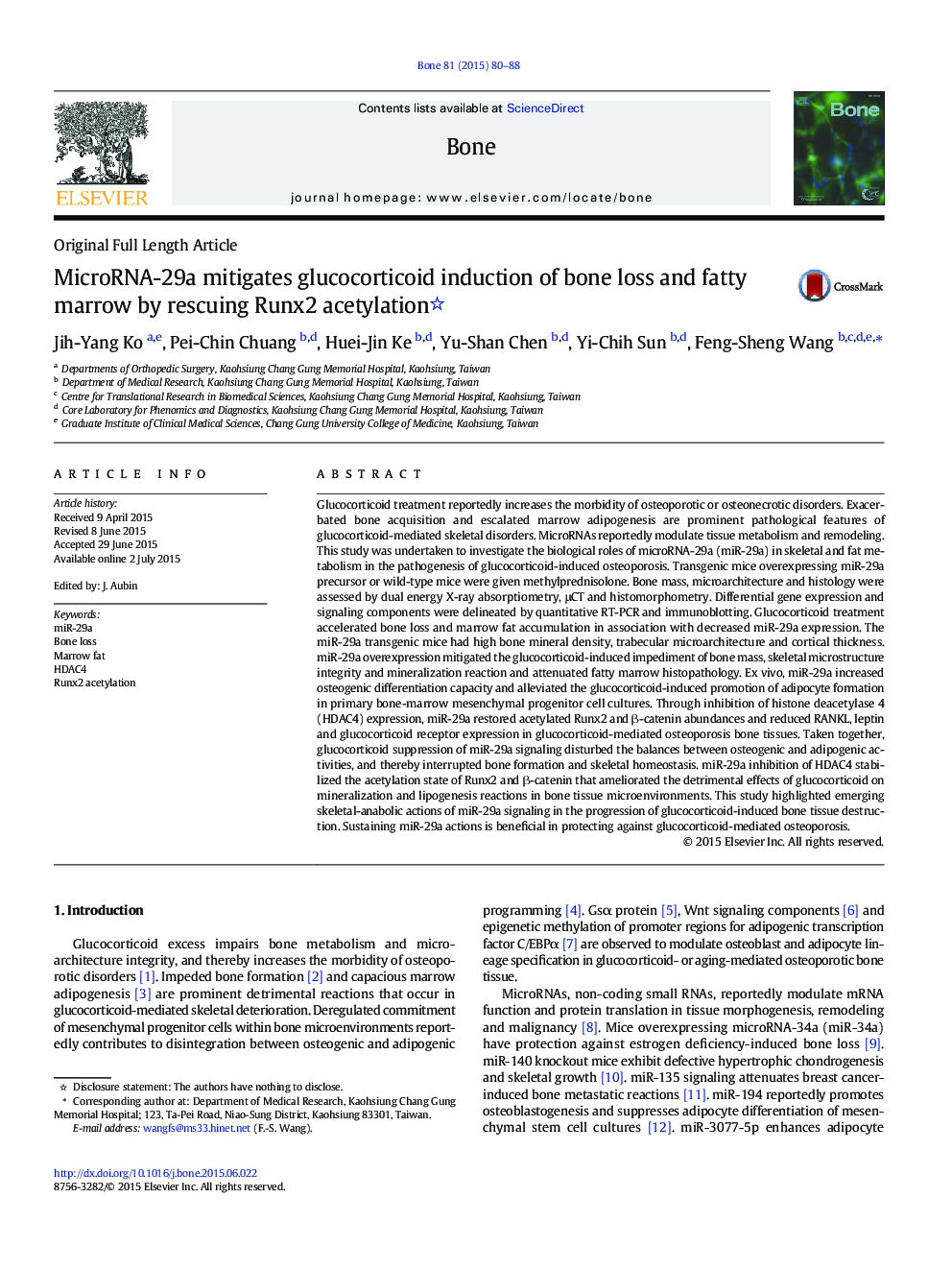| کد مقاله | کد نشریه | سال انتشار | مقاله انگلیسی | نسخه تمام متن |
|---|---|---|---|---|
| 5889234 | 1568138 | 2015 | 9 صفحه PDF | دانلود رایگان |

- Glucocorticoid excess accelerated bone deterioration and marrow fat deposition concomitant with decremented miR-29a signaling.
- The miR-29a transgenic mice had increased bone microarchitecture and reduced responses to the glucocorticoid-induced loss of mineralization and osteogenesis.
- Increment of miR-29a signaling ameliorated the glucocorticoid-induced excessive marrow lipogenesis and ex vivo adipogenic lineage commitment.
- miR-29a inhibited histone deacetylase 4 signaling and restored acetylation state of Runx2 and β-catenin in glucocorticoid-mediated osteoporotic bone tissues.
- This study unveiled the skeletal-anabolic effects of miR-29a signaling that mitigated glucocorticoid-induced bone loss and fatty marrow.
Glucocorticoid treatment reportedly increases the morbidity of osteoporotic or osteonecrotic disorders. Exacerbated bone acquisition and escalated marrow adipogenesis are prominent pathological features of glucocorticoid-mediated skeletal disorders. MicroRNAs reportedly modulate tissue metabolism and remodeling. This study was undertaken to investigate the biological roles of microRNA-29a (miR-29a) in skeletal and fat metabolism in the pathogenesis of glucocorticoid-induced osteoporosis. Transgenic mice overexpressing miR-29a precursor or wild-type mice were given methylprednisolone. Bone mass, microarchitecture and histology were assessed by dual energy X-ray absorptiometry, μCT and histomorphometry. Differential gene expression and signaling components were delineated by quantitative RT-PCR and immunoblotting. Glucocorticoid treatment accelerated bone loss and marrow fat accumulation in association with decreased miR-29a expression. The miR-29a transgenic mice had high bone mineral density, trabecular microarchitecture and cortical thickness. miR-29a overexpression mitigated the glucocorticoid-induced impediment of bone mass, skeletal microstructure integrity and mineralization reaction and attenuated fatty marrow histopathology. Ex vivo, miR-29a increased osteogenic differentiation capacity and alleviated the glucocorticoid-induced promotion of adipocyte formation in primary bone-marrow mesenchymal progenitor cell cultures. Through inhibition of histone deacetylase 4 (HDAC4) expression, miR-29a restored acetylated Runx2 and β-catenin abundances and reduced RANKL, leptin and glucocorticoid receptor expression in glucocorticoid-mediated osteoporosis bone tissues. Taken together, glucocorticoid suppression of miR-29a signaling disturbed the balances between osteogenic and adipogenic activities, and thereby interrupted bone formation and skeletal homeostasis. miR-29a inhibition of HDAC4 stabilized the acetylation state of Runx2 and β-catenin that ameliorated the detrimental effects of glucocorticoid on mineralization and lipogenesis reactions in bone tissue microenvironments. This study highlighted emerging skeletal-anabolic actions of miR-29a signaling in the progression of glucocorticoid-induced bone tissue destruction. Sustaining miR-29a actions is beneficial in protecting against glucocorticoid-mediated osteoporosis.
Journal: Bone - Volume 81, December 2015, Pages 80-88